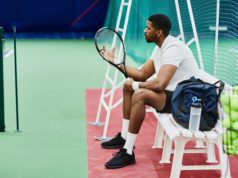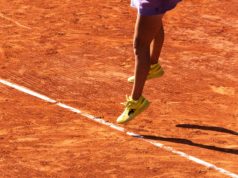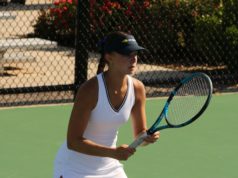Can We Balance Fun & Performance In Our Tennis Programs?
By Willy Campos, UTA/Tennis Director, James Creek Tennis Center
Why not encourage ourselves to become the top developmental tennis state in the United States? As a high-performance coach just joining the Georgia tennis system and all its developmental and recreational branches, I might have a different perspective and understanding of the system. This does not mean different is better, but mixing perspectives can help us grow at every stage of Atlanta’s tennis developmental phases. Combining different coaching philosophies and approaches, we can create a more well-rounded and effective training system for players at all levels.
Developing a successful high-performance tennis program from a recreational foundation requires careful planning to ensure that athletes receive professional-level training while maintaining the enjoyment that drew them to the sport in the first place. This transformation must focus on structured coaching, competitive opportunities, and mental and physical development without eliminating the fun aspects that make tennis an engaging activity. Atlanta has a thriving tennis community, with numerous clubs, leagues, and academies fostering talent at all levels. By leveraging the existing infrastructure and engaging local tennis professionals, recreational programs can evolve into high-performance training systems that cultivate top-tier athletes while preserving a welcoming and enjoyable atmosphere.
Before making changes, it is essential for us to define the objectives of any program. Identifying whether the goal is to develop professional players, secure college scholarships, or simply enhance competitive play, will help us shape the curriculum and create clear pathways for players and will provide motivation and structure while keeping the process engaging.
In Atlanta, many junior players participate in USTA leagues and tournaments, providing a natural transition from recreational to competitive play. We should keep integrating and establishing connections with these organizations to help us bridge the gap and create seamless player development. I truly believe that Georgia’s — and especially Atlanta’s — tennis community could be the greatest developmental structure in the country, and even have the best juniors and professional players within our tennis programs. There are a few steps that could be incorporated into our system, but surely, we have all that is needed to create opportunities for this to happen.
A recreational program could include structured training that builds skills progressively, working on few key aspects such as:
- Technical development — Introducing biomechanically efficient strokes and refining existing techniques.
- Tactical awareness — Teaching players how to construct points and strategize during point playing.
- Physical conditioning — Incorporating some agility, strength, endurance, and injury prevention exercises.
- Mental training — Providing players with the tools to handle pressure and build resilience.
Therefore, by progressively introducing different ideas and strategies, players could develop at a steady pace while staying motivated. We also should encourage listening to other experienced coaches from established training centers in Atlanta who can provide great information from their previous player development experiences, and the systems they used, and even strategies they are actually using at this moment.
Honestly, I believe recreational/high-performance training does not have to be monotonous. Incorporating fun and dynamic drills, team-based competitions, and innovative coaching techniques ensures players remain engaged. Definitely, there are local club programs and academies that have successfully integrated different methods to keep training fresh and engaging for young athletes. Surely there are tons of ideas and strategies that we could add to our programs, including gamified drills that simulate match conditions, team challenges and tournaments to build camaraderie, and cross-training activities that develop athleticism without burnout.
Also, encouraging competition is essential for player growth, but it must be introduced in a way that doesn’t create overwhelming pressure. Creating an environment where winning and losing are learning experiences fosters long-term improvement. There are many friendly competing methods, such as organizing in-house tournaments and friendly match play, but making sure we emphasize learning and growth over just winning, all of this — and much more — will help create the correct mindset.
Atlanta offers various competition opportunities, including USTA and ALTA leagues, as well as UTR events. Integrating these into training schedules ensures players experience competition in a controlled and constructive atmosphere. A strong team culture, where players, coaches, and parents support each other is crucial. We should encourage open communication, celebrate achievements (both big and small), maintain a balance between hard work and enjoyment, prevent burnout, and keep players invested in their development. We also can emphasize mentorship programs. This not only helps skill development but also strengthens community ties within the programs.
Moreover, we need to understand that every player is different, and a recreational/high-performance program should cater to individual needs. Therefore, an effort to customize training plans based on a player’s strengths, weaknesses, and personal goals ensures they stay engaged and continuously improving. Making sure we give positive feedback will help keep motivation high and maintain a healthier environment.
Transitioning a recreational tennis program into a fun, high-performance system requires a delicate balance of discipline and enjoyment. By maintaining structured, goal-oriented training while incorporating fun and motivational elements, we can help players develop to their highest potential without losing their passion for the sport.
Definitively, with Atlanta’s strong tennis culture and resources, recreational programs can evolve into elite training grounds while ensuring that players continue to enjoy the game. Integrating expert coaching, structured competition, and a fun community-driven approach, we can foster the next great generation of high-performance junior tennis players. Let us improve our system, and make sure we are all part of the change!
 GPTA TEACHING PROFESSIONAL SPOTLIGHT: WILLY CAMPOS
GPTA TEACHING PROFESSIONAL SPOTLIGHT: WILLY CAMPOS
Submitted by USTA
Hometown (City/State): Cumming, GA
How did you get involved in teaching tennis? I started playing tennis in 1986 when I was 7 years old. I graduated from Troy University in Alabama in 2001. In college, I was Player of the Year and Freshman of the Year in TAAC Conference, with an individual best singles ranking of #48 and doubles ranking of #19 in NCAA Div. 1.
Diehard fan of what sports team? Barcelona FC and Atlanta Braves
What other sports do you play? I played different sports when I was little, such as futbol, karate, and whatever we had in school.
My favorite player of all time is: Roger Federer
What would you be doing if you were not into tennis? Probably coaching soccer or working at a hospital.
#1 reason why I enjoy teaching & coaching tennis: I have a great passion for helping people and to develop sports skills. I love competition and sports.
“Do over” in my coaching career? I would have coached more on different continents so that I can know their developmental systems and coaching styles.




